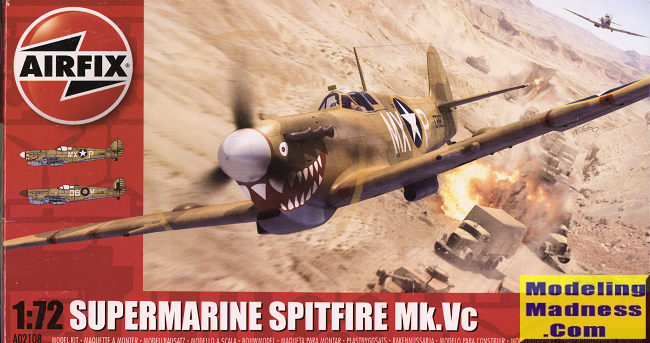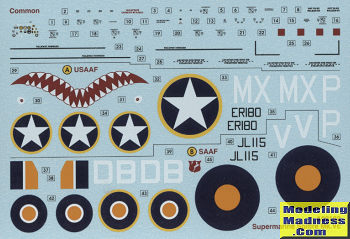
Airfix 1/72 Spitfire Vc
| KIT #: | A02108 |
| PRICE: | $17.00 delivered |
| DECALS: | Two options |
| REVIEWER: | Scott Van Aken |
| NOTES: | 2020 release |

| HISTORY |
The "C-type" wing, or "Universal wing" was a more heavily modified wing, redesigned to reduce labour and manufacturing time, as well as to allow different armament configuration options to be fitted in a single, universal wing structure which could accommodate several different armament layouts without serious structural modification or alteration (a similar kind of wing was developed for the Hawker Hurricane, allowing anything from 8 to 10 .303 Brownings, to four 20mm Hispanos, to twin anti-tank 40mm Vickers "S" guns and a pair of .303's to be fitted into the same wing). Without modification, the "universal" wing could accept "A", "B", "C" or "E-type" armament configuration, although the "E" type wasn't used until later marks of Spitfire. The "B" type, 2-cannon, 4-Browning layout was by far the most commonly seen on "C" wing Spitfires, until the Mk IX and the "E" wing. Differences in the "C" wings include a second cannon-bay added directly alongside the first, and the #3 Browning gun being moved slightly outboard from ribs 13 to 14, making the two outer machine guns closer together than in the older "B" type wing.
Although officially any aircraft with a universal wing is a "C" variant regardless of their armament configuration (excepting "E" types), in later popular (and incorrect) usage, "C" variants with the same armament as the "B" type are often called "B" variants, even though it's technically a "C", and structurally it is different than the older "B" wing Spitfire. The new wing now had two inner gun bays able to accommodate cannon, although one bay was usually left empty. The outer two .303 machine guns were also moved closer together than in "A" or "B" type wings, which is one of the primary visual aids to distinguishing an original "B" type from later universal wing "B types", along with the second pair of cannon ports, which are visible even though typically no weapons are fitted in the second cannon bay. In this case, the empty port is usually closed off with a rubber plug. The cannon mounts were also moved further back in the wing, so the barrel fairings of the cannon are shorter than on an original "B" Spitfire.
Few, if any, "C" Spitfires were built with the eight .303 Browning "A" armament configuration, which was viewed as obsolete by the time the Mk V went into combat. The "C" type wing was the first which could accommodate an all-cannon armament of four 20mm Hispanos; thus the "C" designation is popularly reserved for four-cannon Spitfires (i.e. Mk Vc). The "C" type armament was also rarely used (although not as rare as the "A" armament), due to the extra weight of the added cannon eroding performance and handling. Many Spitfires originally fitted with the "C" armament had the extra cannon removed in the field to save weight. In theory, a "Universal" wing Spitfire could carry an armament of four 20mm cannon and four .303 Brownings, but this would be heavily loading the aircraft indeed, and thus was never used. (An "E" type wing, usually seen in Mk IX and later versions, was similar to the "C" armament, but used a pair of American .50 caliber Browning AN/M2 heavy machine guns in place of the inner pair of Hispanos, giving an armament of two Hispanos and two .50cal Brownings.)
The Universal wing also took into account the fact that the Hispano cannon had been converted to belt-feed, a move which allowed each cannon to carry double the ammunition load, or 120 rpg in ammunition trays instead of 60 rpg as in the original drum-fed cannon of the Mk Vb. This also eliminated the need for under- and over-wing blisters to accommodate the large-diameter ammunition drum, instead only requiring a small blister to cover the electrical "Chattellerault" feed mechanism. The undercarriage mountings were redesigned and the undercarriage doors were bowed in cross section allowing the legs to sit lower in the wells, eliminating the upper-wing blisters over the wheel wells and landing gear pivot points. The stronger undercarriage legs were angled 2 inches (5.08 cm) forward when extended, making the Spitfire more stable on the ground and reducing the likelihood of the aircraft tipping onto its nose. In addition the retractable landing lights were no longer fitted. Structural hard-points were added outboard of the wheel-wells, allowing racks to be fitted under each wing which were capable of carrying one 250 lb (113 kg) bomb each.
| THE KIT |

| CONCLUSIONS |
As usual, this purchase was motivated by a decal sheet. From what I can see, this is probably the best Spit Vc in this scale. At least until something newer comes along.
| REFERENCES |
https://en.wikipedia.org/wiki/Supermarine_Spitfire_(early_Merlin-powered_variants)
Copyright ModelingMadness.com. All rights reserved. No
reproduction in part or in whole without express permission from the editor.
If you would like your product reviewed fairly and fairly quickly, please contact the editor or see other details in the Note to Contributors.